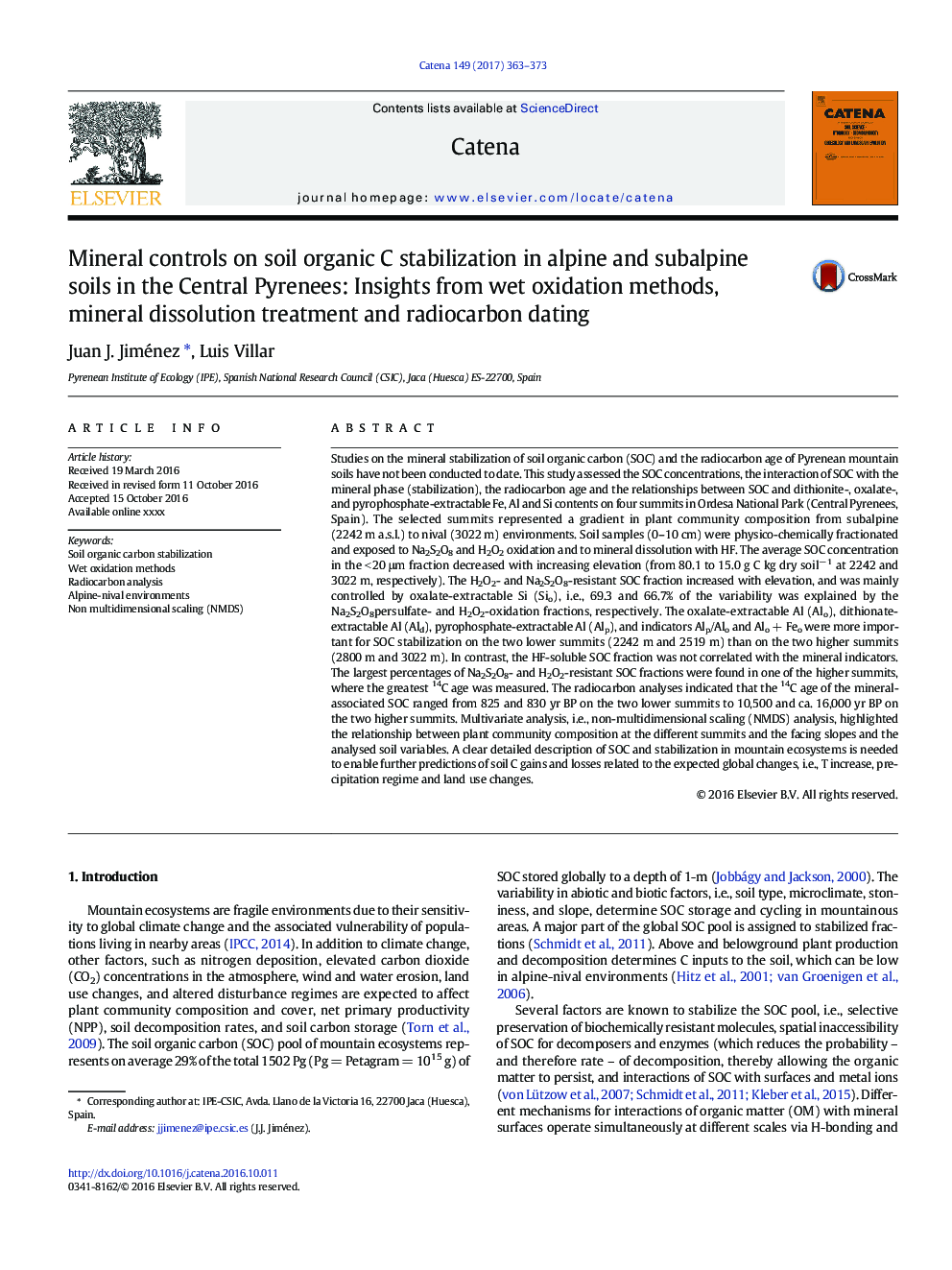| کد مقاله | کد نشریه | سال انتشار | مقاله انگلیسی | نسخه تمام متن |
|---|---|---|---|---|
| 10997843 | 1332079 | 2017 | 11 صفحه PDF | دانلود رایگان |
عنوان انگلیسی مقاله ISI
Mineral controls on soil organic C stabilization in alpine and subalpine soils in the Central Pyrenees: Insights from wet oxidation methods, mineral dissolution treatment and radiocarbon dating
دانلود مقاله + سفارش ترجمه
دانلود مقاله ISI انگلیسی
رایگان برای ایرانیان
کلمات کلیدی
موضوعات مرتبط
مهندسی و علوم پایه
علوم زمین و سیارات
فرآیندهای سطح زمین
پیش نمایش صفحه اول مقاله

چکیده انگلیسی
Studies on the mineral stabilization of soil organic carbon (SOC) and the radiocarbon age of Pyrenean mountain soils have not been conducted to date. This study assessed the SOC concentrations, the interaction of SOC with the mineral phase (stabilization), the radiocarbon age and the relationships between SOC and dithionite-, oxalate-, and pyrophosphate-extractable Fe, Al and Si contents on four summits in Ordesa National Park (Central Pyrenees, Spain). The selected summits represented a gradient in plant community composition from subalpine (2242 m a.s.l.) to nival (3022 m) environments. Soil samples (0-10 cm) were physico-chemically fractionated and exposed to Na2S2O8 and H2O2 oxidation and to mineral dissolution with HF. The average SOC concentration in the < 20 μm fraction decreased with increasing elevation (from 80.1 to 15.0 g C kg dry soilâ 1 at 2242 and 3022 m, respectively). The H2O2- and Na2S2O8-resistant SOC fraction increased with elevation, and was mainly controlled by oxalate-extractable Si (Sio), i.e., 69.3 and 66.7% of the variability was explained by the Na2S2O8persulfate- and H2O2-oxidation fractions, respectively. The oxalate-extractable Al (Alo), dithionate-extractable Al (Ald), pyrophosphate-extractable Al (Alp), and indicators Alp/Alo and Alo + Feo were more important for SOC stabilization on the two lower summits (2242 m and 2519 m) than on the two higher summits (2800 m and 3022 m). In contrast, the HF-soluble SOC fraction was not correlated with the mineral indicators. The largest percentages of Na2S2O8- and H2O2-resistant SOC fractions were found in one of the higher summits, where the greatest 14C age was measured. The radiocarbon analyses indicated that the 14C age of the mineral-associated SOC ranged from 825 and 830 yr BP on the two lower summits to 10,500 and ca. 16,000 yr BP on the two higher summits. Multivariate analysis, i.e., non-multidimensional scaling (NMDS) analysis, highlighted the relationship between plant community composition at the different summits and the facing slopes and the analysed soil variables. A clear detailed description of SOC and stabilization in mountain ecosystems is needed to enable further predictions of soil C gains and losses related to the expected global changes, i.e., T increase, precipitation regime and land use changes.
ناشر
Database: Elsevier - ScienceDirect (ساینس دایرکت)
Journal: CATENA - Volume 149, Part 1, February 2017, Pages 363-373
Journal: CATENA - Volume 149, Part 1, February 2017, Pages 363-373
نویسندگان
Juan J. Jiménez, Luis Villar,